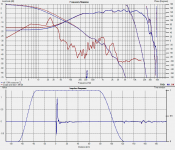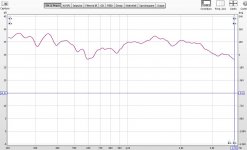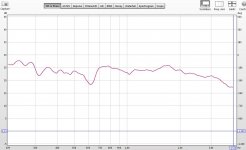You have a big dead room? At 1/3 octave smoothing, or nearfield, they are close. At 1M, 1/24 the differences are large. Below about 200 Hz, I use sweep.
Are you sure it is noise, not diffraction, reflection, basket reflections and other nasties?
measuring distance about 1.2M Similar distance to floor and ceiling. The comment about using sweeps below 200Hz tends to fit with what I recall that I could gate lower with the swept sines. I hypothesized that it was actually late reflections of the MLS signal that were messing things up, and that the swept sines weren't as susceptable (exactly the opposite to what I had read).
I just loaded some old measurements (about 2.5 years ago). I could only find one direct swept sine vs mls measurement and it is very close to identical. So maybe my memory is faulty... blue is MLS red is Swept Sine. Only details I have is that the measurement was taken at 1.5M.
Tony.
Attachments
TVR. Yes, mid-size room, fairly dead. But I get identical results measuring amps and pre-amps, too. Maybe they would not show the difference?
I would really hope an op amp or preamp electrical measurement is not influenced by reflections and refraction from the room. I have not had time to play with MLS for electronic testing. I usually just use my old trusty TrueRTA and spreadsheet for calculating harmonic distortion.
my latest mesurement , not exactly flat but the best sounding to my ears , i managed to get a almost perfect flat curve but sounded like
Ah yes, Grasshopper, you have reached a major step in your path to enlightenment.
Not knowing the details, I might think your BSC is coming in a bit early. Maybe crossovers not positioned quite right. Have you measured the system with each driver independently so you can separate the driver/crossover issues from driver/room issues?
There's nothing wrong with it per se, but for designing the crossover itself the usual thing to do is measure the drivers individually (with gating for most of us without access to an anechoic chamber) and design the crossover based on those measurements.
In room measurements of the drivers without gating will include all sorts of room effects that you might try to correct for in the crossover if you were to try to design with those. what's more slight changes in the positioning of the speakers (from where they were for the original in room measurements) could change the measured response significantly (meaning that those corrections may now be completely wrong for the new position).
Much better IMO to design the crossover with semi anechoic data, allowing phase matching of the drivers etc, and then worry about whether or not to do anything about the peaks and troughs the room introduces once you have the speaker sorted.
I personally have done nothing more than play with the positioning of my speakers when it comes to in room response, and to me it sounds ok. Objectively it doesn't measure too bad either (apart from two big spikes, one at 40Hz and another around 550Hz).
Tony.
In room measurements of the drivers without gating will include all sorts of room effects that you might try to correct for in the crossover if you were to try to design with those. what's more slight changes in the positioning of the speakers (from where they were for the original in room measurements) could change the measured response significantly (meaning that those corrections may now be completely wrong for the new position).
Much better IMO to design the crossover with semi anechoic data, allowing phase matching of the drivers etc, and then worry about whether or not to do anything about the peaks and troughs the room introduces once you have the speaker sorted.
I personally have done nothing more than play with the positioning of my speakers when it comes to in room response, and to me it sounds ok. Objectively it doesn't measure too bad either (apart from two big spikes, one at 40Hz and another around 550Hz).
Tony.
Last edited:
Swept sine has better S/N than MLS.
"Better S/N" means exactly what it says, better signal to noise ratio in the impulse response derived from the measurement. All MLS and sweep measurements apply 'gating' in the process of generating the displayed frequency response from the impulse response, i.e. the impulse response is multiplied by a window function to select the desired portion before calculating and displaying the frequency content of that selected portion. Using narrower gates/shorter time windows allows contributions after the direct sound that arrive outside the window to be removed, but the width of the window also determines the lowest frequency that can be determined. For example, if the speaker and the mic were each at least 5 feet from the nearest surface (floor, wall, ceiling, furniture) a window of 4.4 ms could be applied, as sound takes 4.4 ms to travel 5 feet. The resulting frequency response would then exclude any contribution other than the direct sound from the speaker, but the lowest valid frequency in the response would be 225 Hz (1/0.0044).If you are not using a gated measurement, you are measuring speakers in a room. To measure speakers, use the gated measurements.
When you say "better" does that mean smoother, prettier, or closer to what you think you hear?
Sorry if it is not as pretty, reality is not pretty. If you want to make it pretty, use the averaging function. Don't be fooled by the averaging functions though; they differ product to product.
I think the term "signal to noise" is a very poor choice here. "Signal to spurious signal" may be a better description. Noise implies a unwanted signal riding on the desired signal. Reduction of the spurious signal is exactly what MLS does a sweep can not. Think about the MLS signal. What it really is is the sweep all at once.
I think the term "signal to noise" is a very poor choice here. "Signal to spurious signal" may be a better description. Noise implies a unwanted signal riding on the desired signal. Reduction of the spurious signal is exactly what MLS does a sweep can not. Think about the MLS signal. What it really is is the sweep all at once.
Like Winter said, you need to measure the speaker to design the box and crossover. This is where manufactures have to stop. ( or they guess about your room, usually not very well) DIY has the advantage of putting the speaker system in the place where it will be used for final voicing.
When you do start measuring in-room and at listening position, really quick you will learn you do not want a perfectly flat response. You want to let your brain do the weighting based on the basic acoustics of the room. If you try and fool it, it gets unhappy. Your brain makes a memory as soon as you walk into a room just from ambient sounds.
When you do start measuring in-room and at listening position, really quick you will learn you do not want a perfectly flat response. You want to let your brain do the weighting based on the basic acoustics of the room. If you try and fool it, it gets unhappy. Your brain makes a memory as soon as you walk into a room just from ambient sounds.
That statement is simply incorrect. If you would like to understand how acoustic measurement methods work, including MLS and sweeps, this paper provides a good overview.Reduction of the spurious signal is exactly what MLS does a sweep can not.
"Better S/N" means exactly what it says, better signal to noise ratio in the impulse response derived from the measurement. All MLS and sweep measurements apply 'gating' in the process of generating the displayed frequency response from the impulse response, i.e. the impulse response is multiplied by a window function to select the desired portion before calculating and displaying the frequency content of that selected portion. Using narrower gates/shorter time windows allows contributions after the direct sound that arrive outside the window to be removed, but the width of the window also determines the lowest frequency that can be determined. For example, if the speaker and the mic were each at least 5 feet from the nearest surface (floor, wall, ceiling, furniture) a window of 4.4 ms could be applied, as sound takes 4.4 ms to travel 5 feet. The resulting frequency response would then exclude any contribution other than the direct sound from the speaker, but the lowest valid frequency in the response would be 225 Hz (1/0.0044).
if it takes 4.4ms for sound to travel five feet, assuming the microphone and speaker are both equal distance from the wall, then that gives you a window of at least 8ms to take a reading, as it would take the same time for the reflection sound to travel back to the microphone?
- Status
- This old topic is closed. If you want to reopen this topic, contact a moderator using the "Report Post" button.
- Home
- Loudspeakers
- Multi-Way
- Measuring my speakers



 cpyrighted material removed
cpyrighted material removed